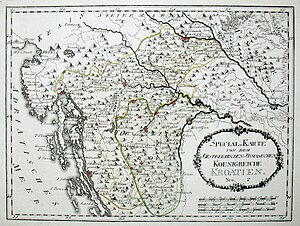| Revision as of 23:47, 28 May 2019 edit2600:1700:47d0:6ca0:9980:449f:931c:7ac2 (talk) →History← Previous edit |
Revision as of 10:28, 30 May 2019 edit undo2001:1c03:4901:3200:802c:dac5:29dc:bd77 (talk) →HistoryNext edit → |
| Line 14: |
Line 14: |
|
==History== |
|
==History== |
|
In Austro-Hungarian military maps from the 16th to 19th century the so-called "Turkish Croatia" appeared as a borderland to ], whose ]-controlled side, in present-day Croatia, was administered directly from ]'s military headquarters. In the 19th century, following the ], and transfer of power in the ] from Ottomans to ] at ] in 1878, the term became redundant, as it no longer served its purpose, and disappeared from official usage completely. The entire territory of ] came under a direct rule of the Viennese government, and since 1908 ] became a new ]. |
|
In Austro-Hungarian military maps from the 16th to 19th century the so-called "Turkish Croatia" appeared as a borderland to ], whose ]-controlled side, in present-day Croatia, was administered directly from ]'s military headquarters. In the 19th century, following the ], and transfer of power in the ] from Ottomans to ] at ] in 1878, the term became redundant, as it no longer served its purpose, and disappeared from official usage completely. The entire territory of ] came under a direct rule of the Viennese government, and since 1908 ] became a new ]. |
|
|
|
|
The term started appearing in unconventional, colloquial usage among some Austria-Hungarian military and political map-makers, in correlation to Ottoman retreat and Austria-Hungarian expansion, and subsequently it was produced in military and ] maps. From here it found its way into narrative of peculiar Croatian far-right national movement based on a constructs of so-called "Hrvatske zemlje" ''({{lang-en|Croatian lands}})'' and "Hrvatsko državno pravo" ''({{lang-en|Croatian state right}})'' (similar to one in Serbia with an expression "Srpske zemlje" ''({{lang-en|Serb lands}})''), which is at the time propagated by political organization called ]. It was typically exploited for the geopolitical purpose and utterance of territorial ambitions and expansionist aspirations of both ] and later Croatia, via transposition of these "rights" on Bosnia and Herzegovina and its historic territory. |
|
|
|
|
|
Although rare, the term was also used in romanticized historiography, as well as in the phantasmagoric politics of "National awakening" and "National integration and homogenization" of late 19th to early 20th century Croatia. In the first half of 20th century with a rise of nationalist fervor, up to the time and establishment of fascist ] in 1940's, this term appeared sporadically again in romantic sloganeering of Nedeljko Mihanović, journalistic and political elaboration in regard to Bosnia and Herzegovina by Frano Milobar, in geopolitical contemplation by ] and Filip Lukas, while getting politically operationalized by ], and finally, in 1940's, implemented by Frank and ] via occupation and incorporation of Bosnia and Herzegovina into Nazi puppet-state, NDH. |
|
|
|
|
|
In more recent times, with a rise of ] and establishment of Republic of Croatia in 1990's, and subsequent politics toward Bosnia and Herzegovina which culminated in ], the term was revived only as part of Croatian far-right nationalist narrative and sparsely as part of their political discourse, with little if any impact on mainstream geopolitics, political geography and historiography, or any of the academic endeavor and research for that matter. The term never took hold outside the scope of political extremism and academic fringes. |
|
|
|
|
|
|
== Maps == |
|
== Maps == |
This territory was usually depicted as roughly comprising the land area between the rivers Vrbas in the east, Sava in the northeast, Una in the northwest, as well as Dinara mountain in the south, including the Cazinska krajina pocket in the far west. Parts of Lika, Banovina and northern Dalmatia were also parts of Turkish Croatia, when its borders went further west.
The term started reappearing in recent times, since 1990's, only in Croatian far-right nationalist political discourse, without any real impact on mainstream politics or academic research.
In Austro-Hungarian military maps from the 16th to 19th century the so-called "Turkish Croatia" appeared as a borderland to Military Frontier, whose Habsburg-controlled side, in present-day Croatia, was administered directly from Vienna's military headquarters. In the 19th century, following the Ottoman–Habsburg wars, and transfer of power in the Bosnia Vilayet from Ottomans to Austrian rule at Berlin Congress in 1878, the term became redundant, as it no longer served its purpose, and disappeared from official usage completely. The entire territory of Bosnia and Herzegovina came under a direct rule of the Viennese government, and since 1908 annexation became a new Crown land.

 "Turkish Croatia" (Türkisch Croatien) on a Austro-Hungarian military map from 1813.
"Turkish Croatia" (Türkisch Croatien) on a Austro-Hungarian military map from 1813.
 An 1827 map of the Ottoman conquest in Europe - A. Finley ("Turkish Croatia" in yellow).
An 1827 map of the Ottoman conquest in Europe - A. Finley ("Turkish Croatia" in yellow).